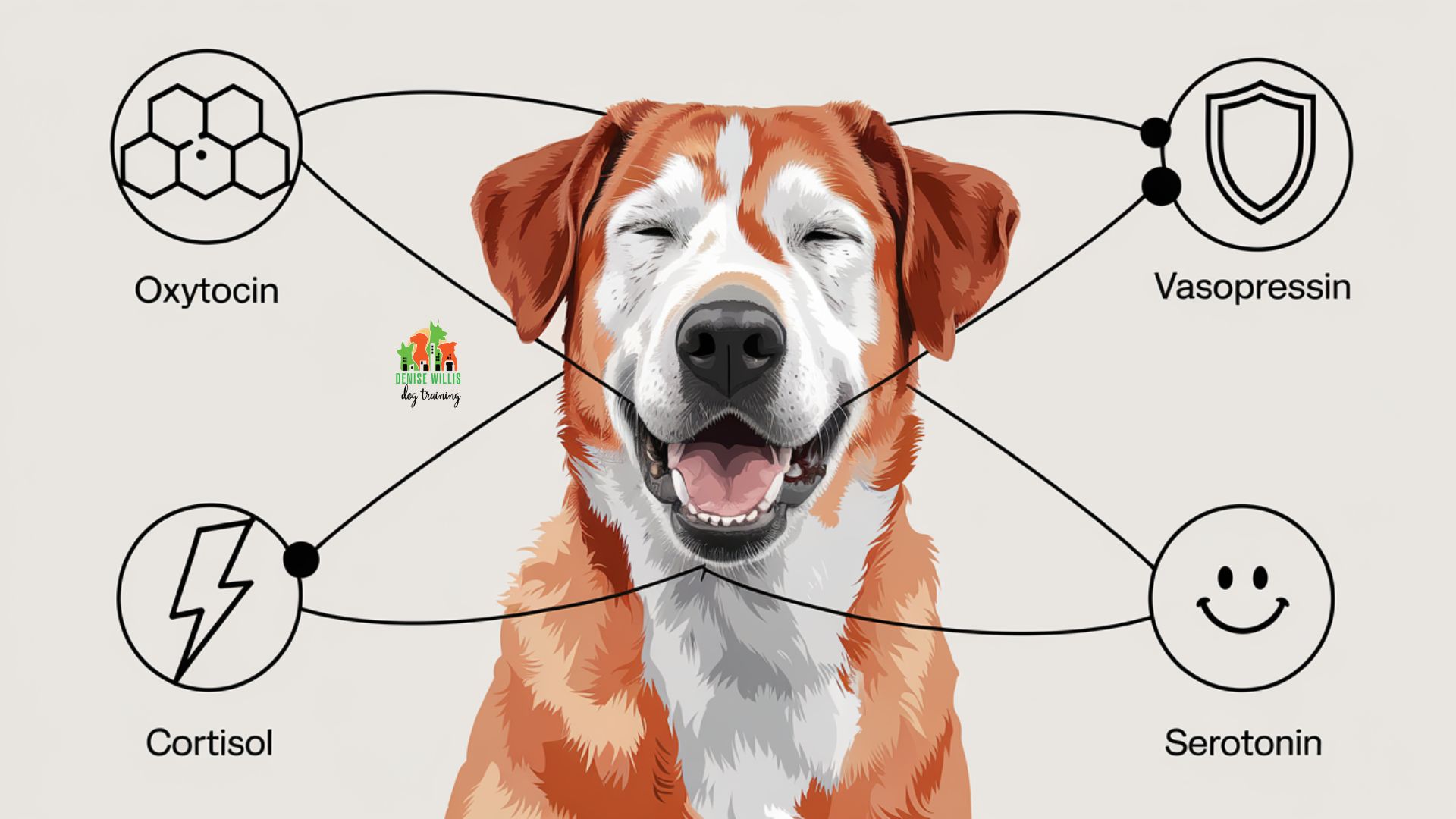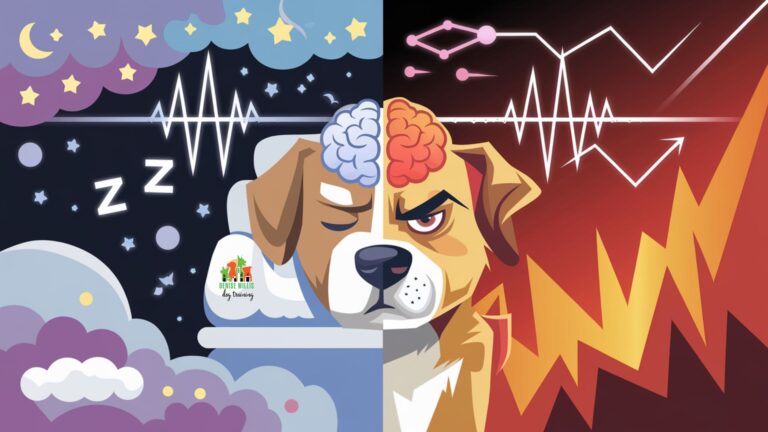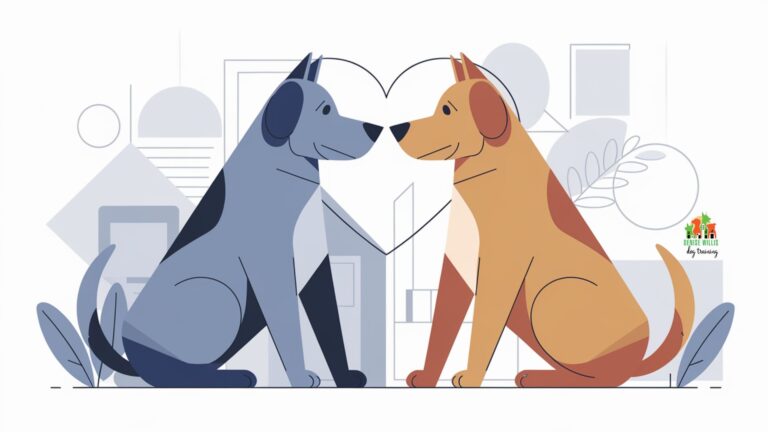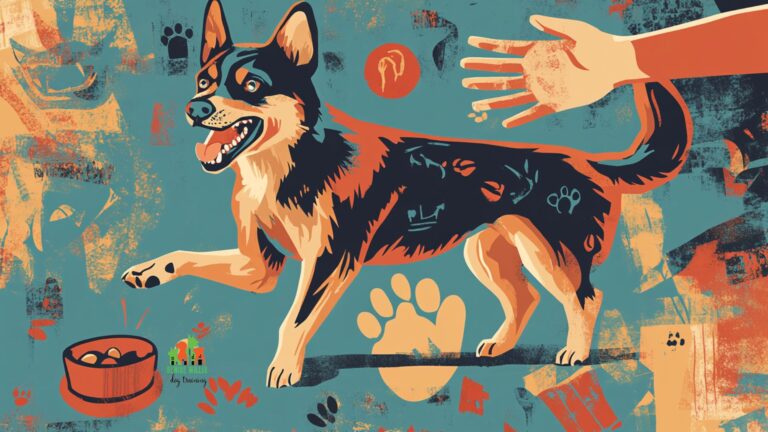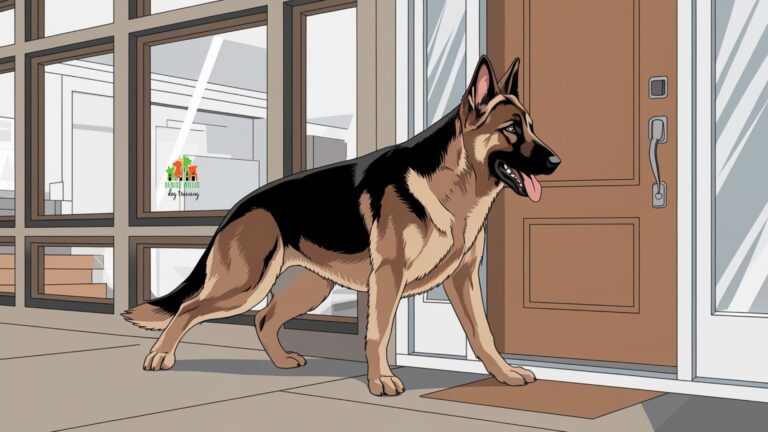Hormones and Hounds: Understanding the Role of Hormones in Dog Aggression
📍 Service Area Notice: DW Dog Training provides in-person training services exclusively in the Greater Baltimore area. While our blog content is designed to help dog owners internationally, our hands-on training services are locally focused. For readers outside our service area, we hope you find value in our articles and welcome you to reach out with questions!
Why does your sweet, lovable pup sometimes transform into a barking bundle of intensity during walks?
The answer flows through their veins. Hormones shape every aspect of canine behavior, including aggression patterns. Research from the University of Arizona reveals that chemical messengers in your dog’s body influence their reactions more than most pet parents realize.
The connection between hormones and dog aggression runs deeper than simple good dog/bad dog labels. Just as human moods shift with chemical changes, dogs experience complex biological responses that affect their behavior. Studies show that service dogs naturally produce different hormone levels compared to other pups, explaining their characteristic calm demeanor.
Some dogs react more intensely to triggers because their bodies process stress differently – not because they’re stubborn or difficult. Understanding these biological differences opens new paths for helping reactive dogs find their balance.
The good news?
Scientific advances offer fresh approaches to supporting dogs through their hormonal challenges.
Your dog’s hormonal makeup is as unique as their pawprint, and recognizing this individuality makes all the difference in addressing aggressive behaviors.
Key Takeaways
- Hormones directly influence your dog’s stress responses and aggressive behaviors
- Each dog processes hormones differently, requiring individualized approaches
- Recent research identifies oxytocin as the “calm chemical” and vasopressin as the “stress signal”
- Environmental factors can trigger hormonal changes in your dog
- Professional support combined with understanding leads to better outcomes
- Training methods work best when aligned with your dog’s natural chemistry
- Early recognition of stress signals helps prevent escalation
- Medical factors sometimes contribute to behavioral changes
Understanding Your Dog’s Hormonal Highway
Remember the last time you felt hangry?
That moment when your mood took a nosedive because your blood sugar dropped?
Your dog’s hormones work in similar ways, affecting their behavior from moment to moment. The only difference? They can’t raid the fridge or “Grab a Snickers” when their chemistry goes wonky.
Research from leading veterinary experts shows that your dog’s body runs on a complex system of chemical signals. These signals don’t just control things like hunger and sleep. They shape how your pup sees and reacts to the world around them.
Quick tip: Just like you might get grumpy when stressed, your dog’s hormone levels can make everyday situations feel more challenging for them.
The Love Hormone: Oxytocin’s Role
Let’s talk about oxytocin. The chemical MVP of good vibes and happy tail wags. Scientists studying service dogs made a fascinating discovery: these canine superstars naturally produce more oxytocin than other dogs.
No wonder they keep their cool under pressure!
Think of oxytocin as your dog’s internal comfort blanket. When they get gentle pets, play with their favorite human, or snuggle up for movie night, their oxytocin levels rise. This chemical boost helps them feel:
- Safe in their environment
- Connected to their family
- Ready to handle new situations
- Calm during stressful moments
When Stress Strikes: Vasopressin’s Impact
Now, meet vasopressin.
The hormone that might make your normally chill pup turn into a fun-sized wolverine at the sight of the mail carrier. Studies reveal that dogs with higher vasopressin levels tend to react more intensely to stress.
But don’t blame it all on vasopressin! This hormone actually plays an important role in your dog’s survival instincts. The trick isn’t eliminating stress responses. It’s helping your dog manage them appropriately.
The Stress-Aggression Connection
Your dog’s stress response system works like a sophisticated home security system. Sometimes it goes off because there’s an actual threat.
Other times?
It might be triggered by a leaf blowing across the yard. The difference lies in how well-calibrated the system is.
Veterinary behaviorists note that stress and aggression often dance together in a complex hormonal tango. One misstep can lead to a cascade of reactions that might look like:
- Increased alertness to normal sounds
- Heightened reactivity to familiar situations
- Changes in eating or sleeping patterns
- Difficulty calming down after excitement
Reading Your Dog’s Stress Signals
Dogs might not speak English, but they’re constantly telling us how they feel.
The secret?
Learning to read their stress signals before the hormonal storm hits full force.
Animal behavior experts identify several key signs that your dog’s stress hormones might be rising:
Body Language Basics:
- Whale eye (showing the whites of their eyes)
- Lip licking when no food is present
- Ears pinned back against their head
- Subtle shifts in body position
Behavioral Changes:
- Avoiding eye contact
- Moving away from interaction
- Freezing in place
- Changes in breathing patterns
Pro Tip: Catching these signals early helps prevent stress from escalating into aggressive responses.
Breaking the Cycle
Good news!
You don’t need a PhD in canine endocrinology to help your dog manage their hormonal responses. Studies show that consistent positive interactions actually change hormone levels over time.
Simple steps for success:
- Create predictable daily routines
- Reward calm behavior consistently
- Provide appropriate exercise outlets
- Allow for decompression time after stressful events
Think of it like helping a friend through anxiety – pushing them to “just get over it” rarely works. Instead, offering support and understanding while they develop better coping skills makes all the difference.
Meet Your Dog’s Chemical Crew
Ever wished your dog came with an instruction manual?
Well, they sort of do. It’s written in hormones!
Think of these chemicals as your pup’s internal DJs, each one playing their own tune in the symphony of behavior. Let’s meet the band members who keep this four-legged concert running!
Quick Pro Tip: Understanding these hormone headlines helps decode why your sweet angel sometimes acts like they’re auditioning for a doggy drama club!
The Hormonal Quartet of Dog Behavior
Oxytocin: The Love Hormone
Your dog’s internal cuddle chemical! Boosts bonding and reduces stress. Service dogs naturally produce 2-3× more than average pups.
Vasopressin: The Stress Signal
The chemical behind your dog’s “fight or flight” response. Reactive dogs show 23% higher levels during stressful encounters.
Cortisol: The Stress Meter
Your dog’s internal alarm system. Just 20 minutes of play can reduce levels by 28%, making for a calmer, happier pup.
Serotonin: The Balance Keeper
Nature’s mood stabilizer. Positive training boosts levels by 55%, helping your dog make better choices naturally.
Beyond the Chemistry
Now that you’ve met the chemical crew running your dog’s behavior backstage, you can see why simple “good dog/bad dog” labels don’t tell the whole story. These hormones are like your pup’s personal weather system – sometimes sunny, sometimes stormy, but always worth understanding.
Quick Pro Tip: Keep this hormone cheat sheet handy. It might explain why your usually brave guard dog turns into a cuddle monster after a good play session!
The Numbers Behind the Barks
Ready for some mind-boggling numbers that’ll make you the smartest human at the dog park? These statistics might surprise you – and no, we’re not counting how many tennis balls your retriever can fit in their mouth at once.
Quick Pro Tip: Understanding these numbers helps explain why your sweet pup sometimes acts like they’re auditioning for a role in “The Good, The Bad, and The Furry.”
| Hormone Effect | Percentage | Impact | Source |
|---|---|---|---|
| Neutering Impact | 40-60% | Reduction in testosterone-related aggression, with 25% increase in fear-based reactions | [Research Gate] |
| Stress Response | 300% | Higher cortisol in chronically stressed dogs, leading to 4.5× more reactive behavior | [Science Daily] |
| SSRI Treatment | 60% | Cases showing improvement within 8-12 weeks of serotonin treatment | [VCA Hospitals] |
| Play Therapy | 28% | Reduction in cortisol levels through 20-minute daily play sessions | [Psychology Today] |
| Positive Training | 55% | Reduction in aggression using reward-based methods that boost oxytocin | [National Geographic] |
Making Sense of the Science
Now that we’ve crunched more numbers than your pup has crunched tennis balls, what’s the takeaway?
It’s simple. Your dog’s behavior isn’t random, and neither are the solutions. Those percentages paint a clear picture. Positive changes happen when we work with our dogs’ natural chemistry instead of against it.
Quick Pro Tip: Keep these stats in your back pocket for the next time someone suggests your dog just needs more discipline. Nothing shuts down outdated advice quite like solid science!
Your Dog’s Hormonal Timeline
Ever noticed how your pup seems to go through more personality changes than a teenager binge-watching TikTok?
Those shifts aren’t random. They’re part of your dog’s natural hormonal journey. Let’s take a walk through the key stages of your four-legged friend’s chemical evolution!
Quick Pro Tip: Click each stage to uncover the hormonal secrets behind your dog’s behavior at that age.
Your Dog’s Hormonal Journey
Puppy Stage (0-6 months)
The foundation stage! Positive experiences during weeks 3-12 boost oxytocin by up to 50%, creating your future calm canine. Early socialization is like giving your pup a chemical confidence boost.
Adolescence (6-18 months)
The teenage phase! Hormone surges can turn your angel into a rebel, but consistent training reduces stress hormones by 30%. Think of it as helping your pup through their awkward phase.
Adult (1.5-7 years)
Prime time! With balanced hormones, 70% of dogs show improved behavior. A healthy diet and regular exercise keep those chemical signals running smooth like a well-oiled machine.
Senior (7+ years)
The golden years! Regular checkups catch 60% of hormone-related issues early. Managing physical comfort reduces stress hormones by half – proving you can teach an old dog new chemical tricks!
Beyond the Timeline
Now that you’ve seen how hormones shape your dog’s journey from bouncy pup to wise senior, you might understand why that sweet little angel sometimes acts like they’re auditioning for a dramatic role in “The Real Housepups of Beverly Hills.” Remember, every dog writes their own chemical story. These are just the chapter titles!
Quick Pro Tip: Share this timeline with your vet to track your dog’s hormonal milestones together.
Beyond Basic Training: The Hormonal Perspective
Training a reactive dog without considering hormones is like trying to bake a cake without measuring ingredients. Sure, you might get lucky sometimes, but understanding the science leads to more consistent results.
Modern research points to a fascinating conclusion: dogs with different hormonal profiles need different training approaches. Some might shine with rapid-fire training sessions, while others need more breaks to process and reset their system.
Success often comes from matching your training style to your dog’s biological needs. For example:
Morning Dogs vs. Evening Dogs:
- Some pups process stress hormones better in the morning
- Others show better learning capacity later in the day
- Timing training sessions to match your dog’s natural rhythm improves results
Length and Intensity:
- Dogs with higher stress responses may need shorter sessions
- Naturally calm dogs often handle longer training periods
- Reading your individual dog’s signals matters more than following rigid rules
Pro Tip: Keep notes on when your dog seems most receptive to training. This information helps identify their optimal learning windows.
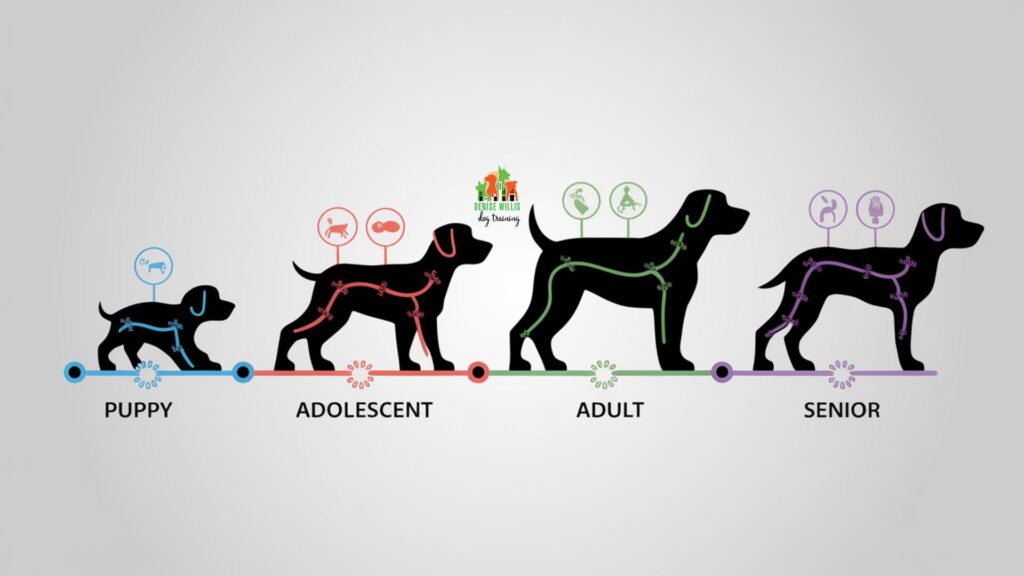
The Role of Medical Support
Has your typically social butterfly of a dog suddenly started growling at their best doggy friends?
Before assuming they’ve joined the canine version of a teenage rebellion, consider that their hormones might be sending an SOS signal.
Veterinary research shows that sometimes what looks like a behavior problem actually stems from medical conditions affecting hormone levels. It’s like when your normally cheerful friend turns grumpy because of a thyroid issue – same concept, just with more fur involved.
Signs your dog’s aggression might have medical roots:
- Sudden personality changes
- Inconsistent reactions to familiar situations
- Changes in sleep or eating patterns
- New physical symptoms alongside behavioral shifts
Quick Pro Tip: Keep a simple diary of behavior changes. This information helps your vet connect the dots between physical and behavioral symptoms.
Collaborative Care Approaches
Helping an aggressive dog isn’t a solo sport. It takes a team. Studies confirm that combining behavioral training with appropriate medical care yields the most successful outcomes. Think of it like a dog-focused version of your favorite sports team, where each professional brings their unique skills to the game.
Your potential support squad might include:
- Regular veterinarian: Your first-line medical expert
- Certified dog trainer: Your behavior modification coach
- Veterinary behaviorist: Your specialist in complex cases
- Animal nutritionist: Your diet and supplement advisor
Each team member contributes their expertise to create a comprehensive care plan tailored to your dog’s specific needs.
Modern Treatment Options
Gone are the days when aggressive dogs were simply labeled “bad.” Research advances have opened new doors for treatment approaches that consider both behavioral and hormonal factors.
Treatment strategies might include:
- Behavior modification programs
- Environmental management techniques
- Medical interventions when needed
- Natural stress-reduction methods
The key?
Finding the right combination for your unique pup. Not every dog needs every treatment option, but every dog needs a plan that respects their individual chemistry.
Success Stories and Real Results
Meet Max, a German Shepherd who went from neighborhood menace to local legend. His owner Sarah worked with a team of professionals who discovered his aggression stemmed from a combination of thyroid issues and learned responses. Through medical support and positive training, Max learned to stay cool even when the neighbor’s cats performed their daily fence-line parade.
Research backs up Max’s transformation. When medical and behavioral professionals work together, dogs show improved response rates compared to using either approach alone.
Product Recommendations
Shopping for a hormonally charged pup?
Your four-legged friend’s inner chemistry set might need some backup support. Let’s look at some products that could help your canine companion find their zen – without turning your home into a doggy meditation retreat.
- ThunderShirt Sport Dog Anxiety Jacket: Like a warm hug for your furry friend, this snug wrap helps dogs feel secure during stressful moments. Your pup might start channeling their inner superhero with this compression cape. Warning: May cause spontaneous cuddle sessions and an unexpected appreciation for fashion.
- PetSafe Gentle Leader Head Collar: Turn your reactive rover into a polite pedestrian with this head halter designed for better control during walks. It’s like power steering for your pup, but without the expensive maintenance fees. Warning: Your dog may temporarily believe they’ve joined a secret society of distinguished canines.
- KONG Extreme Dog Toy: Made for powerful chewers, this durable rubber toy provides a perfect outlet for stress-related chewing. Fill it with treats for extended entertainment value. Warning: Your dog might start expecting you to stuff their entire dinner menu into this magical black cone.
- Zuke’s Mini Naturals Training Treats: Tiny but mighty rewards perfect for positive reinforcement training. These treats are like doggy currency – small enough to hand out frequently but valuable enough to motivate good choices. Warning: Your pup may start performing random good behaviors hoping to cash in.
- PetSafe Busy Buddy Tug-A-Jug: This interactive toy combines play, treats, and mental stimulation. Perfect for redirecting energy into productive puzzle-solving. Warning: May create a dog so clever they start solving your daily crossword puzzle.
While these products won’t magically transform your reactive rocket into a zen master overnight, they’ll certainly make the journey more enjoyable for everyone involved!
Further Reading
Ready to become your neighborhood’s resident dog behavior expert? These articles will take you deeper into the fascinating world of canine psychology. No PhD is required!
- How to Manage Your Dog’s Territorial Aggression: Is your dog trying to claim the entire zip code as their personal kingdom? Learn how to help them downsize their empire to more manageable proportions. Bonus: Includes tips on explaining property lines to your furry real estate mogul.
- Decoding Your Dog: 15 Body Language Signals You Need to Know: Master the art of reading your dog’s secret signals. Finally understand why they give you that judgy look when you eat the last pizza slice. Warning: May result in you unconsciously mimicking dog body language during business meetings.
- Dog Aggression Solutions: A Complete Guide: The ultimate playbook for understanding and addressing aggressive behavior. It’s like having a dog behavior detective manual, minus the deerstalker hat and magnifying glass.
- 5 Proven Strategies to Stop Your Dog’s Aggression Towards Other Dogs: Transform your canine confrontationalist into a social butterfly. Learn how to help your dog make friends instead of frenemies at the dog park.
- Stress-Induced Dog Aggression: Understand how stress affects your dog’s behavior and learn practical strategies for helping them cope. Because everyone deserves a stress-free life – especially your four-legged stress ball.
Quick Pro Tip: Knowledge is power, but knowledge plus treats is even better! Keep those training treats handy while you study up on becoming your dog’s favorite behavior coach.
Test Your Hormone Knowledge!
Think you’ve become a canine hormone expert?
Time to put those brain cells to work! Take this quick quiz to see if you can match wits with your dog’s internal chemistry set. Don’t worry. Unlike your pup’s mood swings, these questions won’t bite!
Quick Pro Tip: Even if you don’t ace it, you’ll still know more about dog hormones than most people at the dog park!
Test Your Knowledge: Hormones and Dog Behavior
Beyond the Quiz
Whether you aced it or learned something new, you're now better equipped to understand your four-legged friend's hormonal adventures. Remember, every correct answer brings you one step closer to speaking your dog's chemical language!
Quick Pro Tip: Share your quiz results with your dog. they might not understand the numbers, but they'll appreciate the extra treats while you celebrate!
Frequently Asked Questions
Q: My dog started showing aggression out of nowhere. Should I be worried?
A: Sudden behavior changes warrant a veterinary check-up. Medical experts emphasize that abrupt personality shifts often signal underlying health issues worth investigating.
Q: Will my dog always need medication for aggression?
A: Not necessarily. Many dogs improve through a combination of medical support and behavior modification. Your veterinary team can help determine the best long-term plan for your pup.
Q: How long does it take to see improvements in aggressive behavior?
A: Timeline varies by dog. Studies indicate that consistent work usually shows results within 4-6 weeks, though complete behavior modification may take longer.
Q: Can diet affect my dog's hormone levels and aggression?
A: Yes! Research shows that nutrition plays a role in hormone regulation. Your vet can recommend appropriate dietary adjustments to support your dog's behavioral health.
Taking the First Step
Spoiler alert: Your reactive rover isn't plotting world domination. They're just trying to figure out their own internal chemistry set! At DW Dog Training, we've seen countless dogs transform from hormone-driven heroes into balanced, confident companions.
Quick Pro Tip: The sooner you start working with your dog's natural tendencies rather than against them, the faster you'll see positive changes.
Ready to help your pup find their balance?
Contact us today. Our science-based approach combined with years of hands-on experience means your dog gets the best of both worlds. It’s like having Einstein and a best friend all rolled into one trainer!
Share Your Success Story
Has your dog's journey through hormonal challenges taught you something amazing?
We'd love to hear about it!
Drop by our Baltimore dog training center or share your story on our website. Your experience might just be the lighthouse another pet parent needs to navigate their own dog's hormone-driven adventures.
Quick Pro Tip: Tag us in your before-and-after videos on social media. Nothing beats seeing those "aha!" moments when your dog finally masters their impulses!
Remember, at DW Dog Training, every tail has a tale, and every bark has a breakthrough waiting to happen.
Let's write your dog's success story together!

